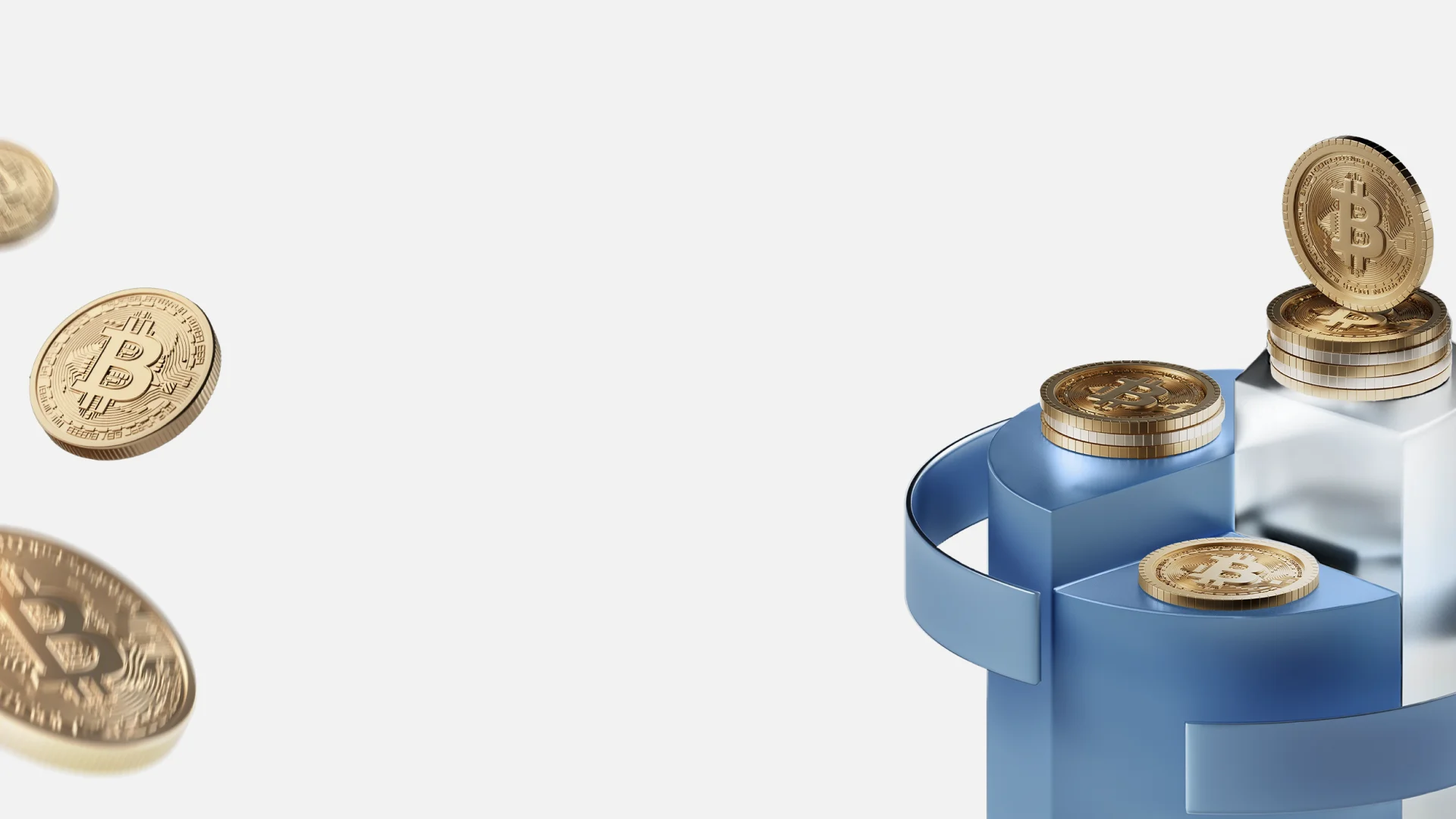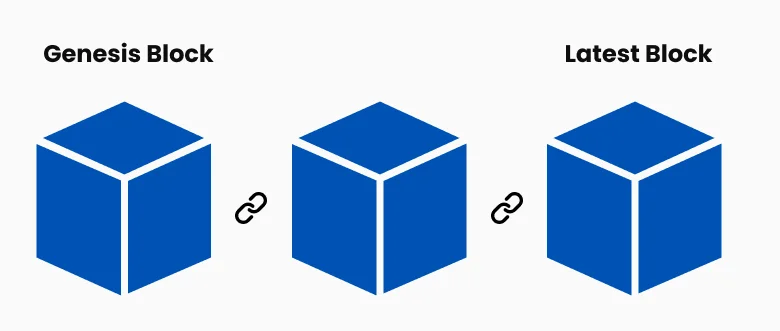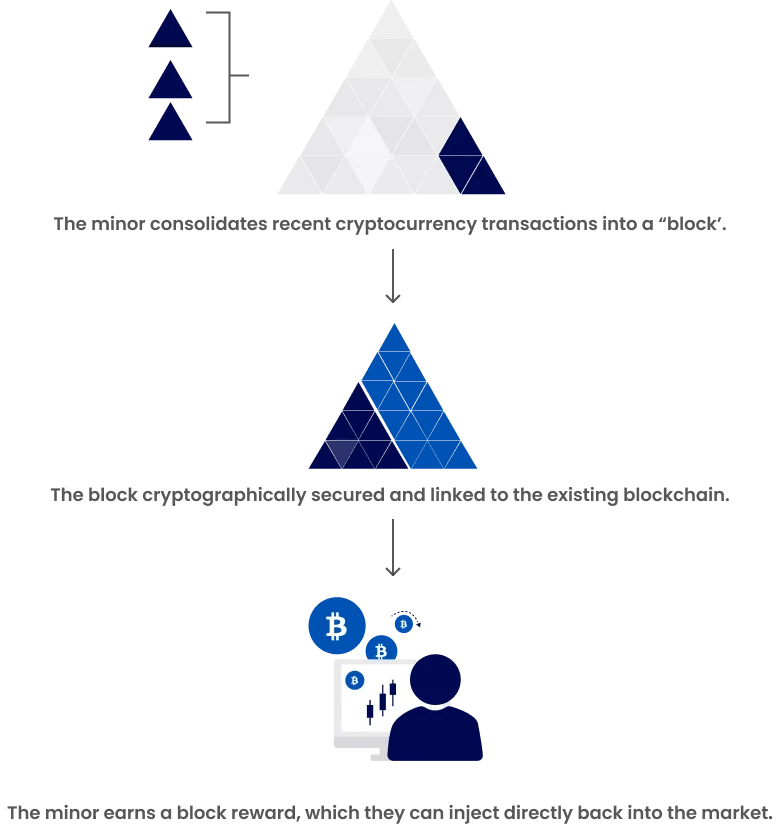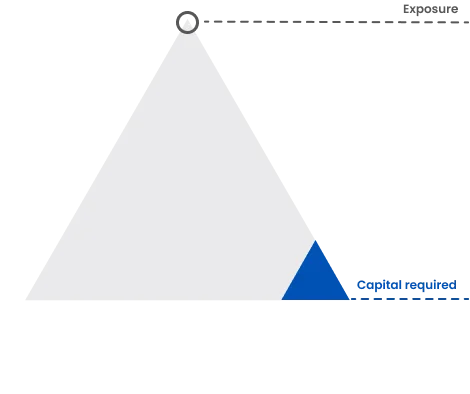

Crypto และการเทรด Crypto คืออะไร
สกุลเงินดิจิทัล (หรือที่เรียกว่า "คริปโต") หมายถึงสกุลเงินดิจิทัลหรือเสมือนจริงที่ได้รับการรักษาความปลอดภัยด้วยการเข้ารหัส ทำให้แทบเป็นไปไม่ได้ที่จะปลอมแปลง แตกต่างจากสกุลเงินแบบดั้งเดิมที่ออกโดยรัฐบาล สกุลเงินคริปโตทำงานบนเครือข่ายแบบกระจายศูนย์ซึ่งอิงกับเทคโนโลยีบล็อกเชน (blockchain) ซึ่งเป็นบัญชีแยกประเภทแบบกระจายที่ได้รับการบังคับใช้โดยเครือข่ายคอมพิวเตอร์หลายเครื่อง
ประเด็นสำคัญ
คริปโตคือสินทรัพย์ดิจิทัลแบบกระจายศูนย์ที่สร้างขึ้นบนเทคโนโลยีบล็อกเชน ช่วยให้สามารถทำธุรกรรมแบบเพียร์ทูเพียร์ได้อย่างปลอดภัย
การเทรดคริปโตสามารถทำได้ผ่าน CFDs หรือที่เรียกว่า การเทรด Crypto CFD หรือผ่านแพลตฟอร์มแลกเปลี่ยนแบบรวมศูนย์ ซึ่งแต่ละแบบมีข้อดีที่แตกต่างกัน
แนวคิดหลักประกอบด้วย เลเวอเรจ, การเทรดมาร์จิ้นล็อต, พิพส์ และสเปรด
การบริหารความเสี่ยงเป็นสิ่งสำคัญในการเทรดคริปโตเนื่องจากความผันผวนของตลาด
การกำเนิดของสกุลเงินดิจิทัล
สกุลเงินดิจิทัลเริ่มต้นจากการสร้าง บิตคอยน์ ในปี 2009 หลังจากวิกฤตการณ์ทางการเงินโลก ในเดือนตุลาคม 2008 บุคคลหรือกลุ่มนิรนามที่ใช้ชื่อแฝงว่า ซาโตชิ นากาโมโตะ ได้เผยแพร่เอกสารไวท์เปเปอร์ชื่อ "Bitcoin: A Peer-to-Peer Electronic Cash System" ซึ่งอธิบายแนวคิดของสกุลเงินดิจิทัลแบบกระจายศูนย์ที่ทำงานโดยไม่มีตัวกลางอย่างธนาคาร
บล็อกบิตคอยน์แรกที่เรียกว่า "บล็อกกำเนิด (genesis block)" ถูกขุดขึ้นเมื่อวันที่ 3 มกราคม 2009 ซึ่งเป็นการเปิดตัวสกุลเงินดิจิทัลแรกของโลกอย่างเป็นทางการ ในช่วงปีแรก ๆ บิตคอยน์ถูกใช้โดยกลุ่มผู้สนใจเทคโนโลยีและผู้สนับสนุนความเป็นส่วนตัว หนึ่งในการทำธุรกรรมที่มีชื่อเสียงในปี 2010 คือการซื้อพิซซ่าสองถาดด้วยบิตคอยน์ 10,000 เหรียญ (มูลค่าหลายพันล้านดอลลาร์ในราคาปัจจุบัน)
หลังจากการสร้างบิตคอยน์' สกุลเงินดิจิทัลอื่น ๆ ก็เริ่มปรากฏขึ้น:

รูปที่ 1: แสดงสกุลเงินดิจิทัลอื่น ๆ
ไลต์คอยน์ (2011) – สร้างขึ้นเป็นทางเลือกที่ "เบากว่า" บิตคอยน์ พร้อมเวลาทำธุรกรรมที่เร็วขึ้น
ริปเปิล (2012) – พัฒนาสำหรับระบบชำระเงินของสถาบัน
อีเธอเรียม (2015)– แนะนำสมาร์ตคอนแทรกต์และแอปพลิเคชันแบบกระจายศูนย์
มีสกุลเงินดิจิทัลอีกหลายพันสกุลตามมา โดยแต่ละสกุลมีคุณสมบัติและวัตถุประสงค์ที่แตกต่างกัน
ลักษณะสำคัญของสกุลเงินดิจิทัล
สกุลเงินดิจิทัลเป็นสินทรัพย์ดิจิทัลที่ออกแบบมาเพื่อทำหน้าที่เป็นสื่อกลางในการแลกเปลี่ยนโดยไม่ต้องพึ่งพาหน่วยงานกลาง เช่น รัฐบาลหรือธนาคาร พวกมันทำงานบนเครือข่ายแบบกระจายศูนย์และได้รับการปกป้องด้วยเทคนิคการเข้ารหัสขั้นสูง เพื่อความปลอดภัยและป้องกันการปลอมแปลง แตกต่างจากสกุลเงินฟิอทแบบดั้งเดิม สกุลเงินดิจิทัลมีอยู่ในรูปแบบดิจิทัลล้วน ๆ ไม่มีตัวตนทางกายภาพ
สกุลเงินดิจิทัลหลายสกุล เช่น บิตคอยน์ มีจำนวนจำกัด โดยมีการกำหนดจำนวนสูงสุดไว้ล่วงหน้า (เช่น บิตคอยน์มีขีดจำกัดที่ 21 ล้านเหรียญ) ซึ่งช่วยสร้างความขาดแคลนและมีผลต่อมูลค่าในระยะยาว
การเทรดสกุลเงินดิจิทัลคืออะไร?
การเทรดสกุลเงินดิจิทัลเกี่ยวข้องกับการเก็งกำไรจากการเคลื่อนไหวของราคาผ่านบัญชีเทรด CFD หรือการซื้อขายเหรียญจริงผ่านแพลตฟอร์มแลกเปลี่ยน กิจกรรมนี้ช่วยให้นักเทรดสามารถทำกำไรจากความผันผวนของตลาดคริปโตได้
นักเทรดมักใช้กลยุทธ์ที่แตกต่างกันขึ้นอยู่กับเป้าหมายและความเสี่ยงที่ยอมรับได้ การเทรดรายวัน เน้นการเคลื่อนไหวระยะสั้น โดยเปิดและปิดสถานะภายในวันเดียวกัน การเทรดสวิง เกี่ยวข้องกับการถือสถานะเป็นเวลาหลายวันหรือหลายสัปดาห์เพื่อจับการเคลื่อนไหวของราคาในวงกว้าง ขณะที่ การเทรดสปอต หมายถึงการซื้อขายสกุลเงินดิจิทัลในราคาตลาดปัจจุบันเพื่อเป็นเจ้าของโดยตรงโดยไม่ใช้เลเวอเรจ วิธีการแต่ละแบบมีความเสี่ยงและข้อดีของตัวเอง การเลือกกลยุทธ์ที่เหมาะสมขึ้นอยู่กับสไตล์และมุมมองของนักเทรด
สองวิธีหลักในการเทรดคริปโต
#1 เทรด Crypto CFDs กับ TMGM
Crypto CFDs (สัญญาสำหรับความแตกต่าง) เป็นตราสารอนุพันธ์ของสกุลเงินดิจิทัลที่ช่วยให้คุณเก็งกำไรจากการเคลื่อนไหวของราคาโดยไม่ต้องเป็นเจ้าของเหรียญจริง ด้วย Crypto CFDs ของ TMGM':
คุณสามารถเปิดสถานะซื้อ ('long') หากคิดว่าราคาคริปโตจะเพิ่มขึ้น
คุณสามารถเปิดสถานะขาย ('short') หากคิดว่าราคาคริปโตจะลดลง
ทั้งสองวิธีใช้ผลิตภัณฑ์ที่มีเลเวอเรจ หมายความว่าคุณต้องวางเงินมัดจำเพียงเล็กน้อย—เรียกว่ามาร์จิ้น—เพื่อเปิดรับความเสี่ยงเต็มรูปแบบในตลาด
กำไรหรือขาดทุนของคุณจะคำนวณจากขนาดเต็มของสถานะ
เลเวอเรจจะช่วยเพิ่มทั้งกำไรและขาดทุนที่อาจเกิดขึ้น
#2 การซื้อขายสกุลเงินดิจิทัลผ่าน แพลตฟอร์มแลกเปลี่ยนแบบรวมศูนย์
เมื่อคุณซื้อคริปโตผ่านแพลตฟอร์มแลกเปลี่ยน:
คุณซื้อเหรียญจริง
คุณต้องสร้างบัญชีแลกเปลี่ยน
คุณต้องวางเงินเต็มจำนวนของสินทรัพย์เพื่อเปิดสถานะ
คุณต้องเก็บเหรียญคริปโตไว้ในกระเป๋าเงินดิจิทัลจนกว่าคุณ'จะพร้อมขาย
การเทรดผ่านแพลตฟอร์มแลกเปลี่ยนมีความท้าทาย:
เส้นทางการเรียนรู้ที่สูงเพื่อเข้าใจเทคโนโลยี
ความยากในการตีความข้อมูลตลาด
ข้อจำกัดในการฝากเงินบนหลายแพลตฟอร์ม
ค่าใช้จ่ายในการดูแลบัญชีที่อาจสูง
ความกังวลด้านความปลอดภัยในการจัดการกระเป๋าเงิน
ตลาดสกุลเงินดิจิทัลทำงานอย่างไร?
ตลาดสกุลเงินดิจิทัลดำเนินการบนพื้นฐานที่แตกต่างจากตลาดการเงินแบบดั้งเดิม:
โครงสร้างเครือข่ายแบบกระจายศูนย์
ตลาดสกุลเงินดิจิทัลเป็นแบบกระจายศูนย์ หมายความว่าไม่ได้ถูกออกหรือรับรองโดยหน่วยงานกลาง เช่น รัฐบาล แต่ทำงานผ่านเครือข่ายคอมพิวเตอร์ แม้จะเป็นแบบกระจายศูนย์ แต่สกุลเงินดิจิทัลสามารถซื้อขายผ่านแพลตฟอร์มแลกเปลี่ยนและเก็บไว้ใน 'กระเป๋าเงินดิจิทัล'
บันทึกความเป็นเจ้าของสินทรัพย์ดิจิทัล
แตกต่างจากสกุลเงินทั่วไป สกุลเงินดิจิทัล มีอยู่ในรูปแบบบันทึกดิจิทัลที่แชร์ร่วมกันบนบล็อกเชน เมื่อผู้ใช้ต้องการส่งหน่วยคริปโตไปยังผู้ใช้อื่น จะส่งไปยังกระเป๋าเงินดิจิทัลของผู้รับ การทำธุรกรรมจะไม่ถือว่าสมบูรณ์จนกว่าจะได้รับการตรวจสอบและบันทึกลงในบล็อกเชนผ่านกระบวนการขุด นี่คือวิธีที่เหรียญคริปโตใหม่ส่วนใหญ่ถูกสร้างขึ้น
เทคโนโลยีบล็อกเชนคืออะไร?
บล็อกเชนคือสมุดบันทึกดิจิทัลที่แชร์ร่วมกันของข้อมูลที่บันทึกไว้ สำหรับสกุลเงินดิจิทัล นี่คือประวัติการทำธุรกรรมของทุกหน่วยคริปโตที่แสดงการเปลี่ยนแปลงความเป็นเจ้าของตลอดเวลา บล็อกเชนทำงานโดยการบันทึกธุรกรรมใน 'บล็อก' และเพิ่มบล็อกใหม่ที่ส่วนหน้าของโซ่

รูปที่ 2: แสดงภาพบล็อกเชน
คุณสมบัติด้านความปลอดภัยขั้นสูงของคริปโตและบล็อกเชนคุณสมบัติความปลอดภัยเฉพาะตัว
เทคโนโลยีบล็อกเชนมีคุณสมบัติด้านความปลอดภัยที่ไม่เหมือนกับไฟล์คอมพิวเตอร์ทั่วไป:
กลไกฉันทามติในเครือข่ายคริปโต
ไฟล์บล็อกเชนจะถูกเก็บไว้บนคอมพิวเตอร์หลายเครื่องในเครือข่าย – แทนที่จะเก็บไว้ในที่เดียว – และมักจะเปิดให้ทุกคนในเครือข่ายอ่านได้ ซึ่งทำให้โปร่งใสและยากต่อการแก้ไข โดยไม่มีจุดอ่อนเดียวที่เสี่ยงต่อการถูกแฮ็กหรือเกิดข้อผิดพลาดจากมนุษย์หรือซอฟต์แวร์
พื้นฐานการเข้ารหัสของคริปโต
บล็อกถูกเชื่อมโยงกันด้วยการเข้ารหัส – คณิตศาสตร์และวิทยาการคอมพิวเตอร์ขั้นสูง ความพยายามใด ๆ ที่จะเปลี่ยนแปลงข้อมูลจะทำให้การเชื่อมโยงเข้ารหัสระหว่างบล็อกเสียหายและสามารถถูกตรวจจับได้อย่างรวดเร็วว่าเป็นการปลอมแปลงโดยคอมพิวเตอร์ในเครือข่าย
การขุดสกุลเงินดิจิทัลคืออะไร?
การขุดคริปโตคือการตรวจสอบธุรกรรมล่าสุดและเพิ่มบล็อกใหม่ลงในบล็อกเชน
วิธีการตรวจสอบธุรกรรมบนบล็อกเชน
การตรวจสอบธุรกรรม: คอมพิวเตอร์ขุดจะเลือกธุรกรรมที่รอดำเนินการจากกลุ่มและตรวจสอบให้แน่ใจว่าผู้ส่งมีเงินเพียงพอสำหรับทำธุรกรรมนั้น โดยตรวจสอบรายละเอียดธุรกรรมกับประวัติธุรกรรมที่เก็บไว้ในบล็อกเชน การตรวจสอบครั้งที่สองยืนยันว่าผู้ส่งอนุญาตให้โอนเงินโดยใช้กุญแจส่วนตัวของตน
การสร้างบล็อกใหม่: คอมพิวเตอร์ขุดจะรวบรวมธุรกรรมที่ถูกต้องเป็นบล็อกใหม่และพยายามสร้างการเชื่อมโยงเข้ารหัสกับบล็อกก่อนหน้าโดยแก้สมการที่ซับซ้อน เมื่อคอมพิวเตอร์เครื่องใดประสบความสำเร็จในการสร้างการเชื่อมโยงนี้ จะเพิ่มบล็อกลงในเวอร์ชันบล็อกเชนของตนและกระจายการอัปเดตไปทั่วเครือข่าย
รูปที่ 3: แสดงภาพการขุดสกุลเงินดิจิทัล
อะไรเป็นตัวขับเคลื่อนตลาดคริปโต?
ตลาดคริปโตเคลื่อนไหวตามอุปสงค์และอุปทาน อย่างไรก็ตาม เนื่องจากเป็นแบบกระจายศูนย์ จึงไม่ถูกควบคุมโดยปัจจัยทางเศรษฐกิจและการเมืองหลายอย่างที่ส่งผลต่อตลาดสกุลเงินทั่วไป
ปัจจัยสำคัญที่มีผลต่อราคาคริปโต
แม้ว่ายังมีความไม่แน่นอนมากเกี่ยวกับคริปโต แต่ปัจจัยต่อไปนี้สามารถส่งผลกระทบอย่างมีนัยสำคัญต่อราคา:
อุปทาน: จำนวนเหรียญทั้งหมดและอัตราการปล่อย ทำลาย หรือสูญหาย
มูลค่าตลาด: มูลค่าของเหรียญทั้งหมดที่มีอยู่และการรับรู้ของผู้ใช้เกี่ยวกับการพัฒนา
การรายงานข่าว: วิธีที่คริปโตถูกนำเสนอในสื่อและปริมาณการรายงานข่าว
การบูรณาการ: ระดับที่คริปโตสามารถผสานเข้ากับโครงสร้างพื้นฐานที่มีอยู่ เช่น ระบบชำระเงินอีคอมเมิร์ซ
เหตุการณ์สำคัญ: เหตุการณ์ใหญ่ เช่น การอัปเดตกฎระเบียบ การละเมิดความปลอดภัย และปัญหาเศรษฐกิจ
การเทรดคริปโตกับ TMGM ทำงานอย่างไร
กับ TMGM คุณสามารถเทรดคริปโตผ่านบัญชี CFD – ผลิตภัณฑ์อนุพันธ์ที่ช่วยให้คุณเก็งกำไรว่าคริปโตที่คุณเลือกจะขึ้นหรือลง ราคาจะอ้างอิงในสกุลเงินทั่วไป เช่น ดอลลาร์สหรัฐ และคุณจะไม่เป็นเจ้าของคริปโตจริง
CFD เป็นผลิตภัณฑ์ที่ใช้เลเวอเรจ หมายความว่าคุณสามารถเปิดสถานะด้วยเงินเพียงส่วนหนึ่งของมูลค่าการเทรดทั้งหมด แม้เลเวอเรจจะช่วยเพิ่มกำไร แต่ก็สามารถเพิ่มขาดทุนได้หากตลาดเคลื่อนไหวสวนทางกับคุณ
คำศัพท์สำคัญในการเทรดคริปโต
ทำความเข้าใจสเปรดของ Crypto CFD
สเปรดคือความแตกต่างระหว่างราคาซื้อและราคาขายที่เสนอสำหรับคริปโต เหมือนกับตลาดการเงินหลายแห่ง เมื่อคุณเปิดสถานะในตลาดคริปโต คุณจะเห็นราคาสองราคา:
เพื่อเปิดสถานะซื้อ คุณจะเทรดที่ราคาซื้อ ซึ่งสูงกว่าราคาตลาดเล็กน้อย
เพื่อเปิดสถานะขาย คุณจะเทรดที่ราคาขาย ซึ่งต่ำกว่าราคาตลาดเล็กน้อย
ล็อตในการเทรดคริปโตคืออะไร?
คริปโตมักถูกเทรดเป็นล็อต –ชุดของโทเค็นคริปโตที่ใช้มาตรฐานขนาดการเทรด เนื่องจากคริปโตมีความผันผวนสูง ล็อตมักจะมีขนาดเล็ก ส่วนใหญ่เป็นเพียงหนึ่งหน่วยของคริปโตหลัก อย่างไรก็ตาม บางสกุลถูกเทรดในล็อตที่ใหญ่กว่า
เลเวอเรจทำงานอย่างไรในการเทรดคริปโต
เลเวอเรจคือวิธีการเปิดรับความเสี่ยงในสกุลเงินดิจิทัลจำนวนมากโดยไม่ต้องจ่ายมูลค่าการเทรดเต็มจำนวนล่วงหน้า คุณเพียงวางเงินมัดจำเล็กน้อยที่เรียกว่ามาร์จิ้น เมื่อคุณปิดสถานะที่ใช้เลเวอเรจ กำไรหรือขาดทุนจะคำนวณจากขนาดเต็มของการเทรด
แม้เลเวอเรจจะช่วยเพิ่มกำไร แต่ก็เพิ่มความเสี่ยงของขาดทุนที่สูงขึ้น—รวมถึงขาดทุนที่อาจเกินมาร์จิ้นของคุณในแต่ละการเทรด ดังนั้นการเรียนรู้วิธีบริหารความเสี่ยงในการเทรดที่ใช้เลเวอเรจจึงสำคัญมาก
รูปที่ 3: แสดงภาพเลเวอเรจ
อธิบายมาร์จิ้นคริปโต
มาร์จิ้นเป็นส่วนสำคัญของการเทรดที่ใช้เลเวอเรจ คือเงินมัดจำเริ่มต้นที่คุณวางเพื่อเปิดและรักษาสถานะที่ใช้เลเวอเรจ เมื่อเทรดคริปโตด้วยมาร์จิ้น ความต้องการมาร์จิ้นจะเปลี่ยนแปลงตามโบรกเกอร์และขนาดการเทรด
มาร์จิ้นมักแสดงเป็นเปอร์เซ็นต์ของขนาดเต็มของสถานะ เช่น การเทรดบิตคอยน์ (BTC) อาจต้องวางเงินมาร์จิ้น 10% ของมูลค่าทั้งหมดเพื่อเปิดสถานะ แทนที่จะต้องวางเงิน 5,000 ดอลลาร์ คุณเพียงวางเงิน 500 ดอลลาร์
การวัดการเคลื่อนไหวของราคาคริปโตด้วยพิพส์
พิพส์คือหน่วยที่ใช้วัดการเคลื่อนไหวของราคาคริปโต หมายถึงการเคลื่อนไหวหนึ่งหลักในราคาที่ระดับที่กำหนด โดยทั่วไปคริปโตที่มีมูลค่าสูงจะเทรดในระดับ 'ดอลลาร์' เช่น การเคลื่อนไหวจากราคา 190.00 ดอลลาร์เป็น 191.00 ดอลลาร์ จะถือว่าเป็นการเคลื่อนไหวหนึ่งพิพส์ อย่างไรก็ตามคริปโตที่มีมูลค่าต่ำกว่าจะเทรดในสเกลที่แตกต่างกัน ซึ่งพิพส์อาจหมายถึงเซนต์หรือเศษส่วนของเซนต์
ก่อนเปิดการเทรด ควรอ่านรายละเอียดบนแพลตฟอร์มเทรดของ TMGM' เพื่อให้เข้าใจระดับที่ใช้วัดการเคลื่อนไหวของราคา
เริ่มต้นกับการเทรด Crypto CFD ของ TMGM'
เปิดบัญชี: ลงทะเบียนกับ TMGM และทำการยืนยันตัวตน
ฝากเงิน: เติมเงินในบัญชีของคุณด้วยวิธีการชำระเงินที่ปลอดภัย
เลือกสกุลเงินดิจิทัล: เลือกจาก Crypto CFDs ที่มีให้
วิเคราะห์ตลาด: ใช้เครื่องมือของ TMGM' เพื่อประเมินโอกาสการเทรด
กำหนดขนาดสถานะ: กำหนดเลเวอเรจและความต้องการมาร์จิ้นของคุณ
บริหารความเสี่ยง: ตั้งระดับหยุดขาดทุนและทำกำไร
ดำเนินการเทรด: เปิดสถานะซื้อหรือขายตามมุมมองตลาดของคุณ
ติดตามและปิดสถานะ: ติดตามสถานะและปิดเมื่อเหมาะสม
การบริหารความเสี่ยงในการเทรดคริปโต
ธรรมชาติที่ผันผวนของตลาดคริปโตทำให้การบริหารความเสี่ยงเป็นสิ่งจำเป็น:
ใช้คำสั่งหยุดขาดทุนเพื่อจำกัดการขาดทุนที่อาจเกิดขึ้น
พิจารณาใช้คำสั่งหยุดแบบรับประกันเพื่อป้องกันเพิ่มเติมในช่วงเหตุการณ์ตลาดสำคัญ
รักษาระดับเลเวอเรจให้อยู่ในระดับเหมาะสมเพื่อหลีกเลี่ยงการเปิดรับความเสี่ยงเกินควร
กระจายการลงทุนในคริปโตและสินทรัพย์ประเภทอื่น
อย่าเสี่ยงเกินกว่าที่คุณจะรับได้
ติดตามข่าวสารและพัฒนาการของตลาดอย่างสม่ำเสมอ
คอร์สและเครื่องมือเรียนรู้การเทรดคริปโตฟรี
การเป็นนักเทรดที่ประสบความสำเร็จต้องใช้ทักษะ ความรู้ และการฝึกฝน TMGM มีทุกอย่างที่คุณต้องการเพื่อไปถึงจุดนั้น พร้อมคอร์สและสัมมนาออนไลน์ฟรีมากมาย นอกจากนี้ยังมี บัญชีทดลองฟรี ที่มีเงินเสมือนจริง 100,000 ดอลลาร์สหรัฐ เพื่อช่วยสร้างความมั่นใจในสภาพแวดล้อมที่ไม่มีความเสี่ยง
เรายังมีข้อมูลเชิงลึกเกี่ยวกับกลยุทธ์การเทรด การวิเคราะห์ตลาด, และบทความข่าวสำหรับทุกระดับประสบการณ์— ดังนั้นไม่ว่าคุณจะเป็นมือใหม่หรือเทรดเดอร์มืออาชีพ TMGM มีสิ่งที่เหมาะกับคุณ
เทรดอย่างชาญฉลาดวันนี้






เข้าบัญชี
ได้ทันที





